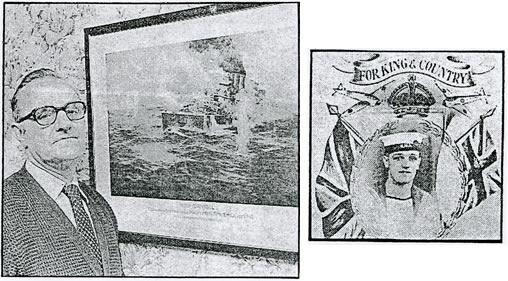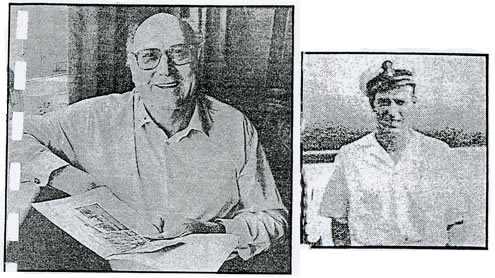The Stories of Two Newport Sailors
Two British Cruisers Sunk Off India
By Jim Dyer
First published in the Western Mail 1988
© Jim Dyer 2012
On April 5th 1942, two British cruisers were bombed and sunk east of Ceylon by the Japanese Pearl Harbour fleet.
At the end of 1941 Nagumo's powerful Japanese naval force was rampaging through the Pacific and the Far East.
They had already devastated the American navy at Pearl Harbour and the mighty British battlecruisers, Repulse and the Prince of Wales, were victims off the east coast of Malaya. This was only the beginning - the Japanese were thirsty for more successes.
As 1941 turned into 1942, there was to be intense conflict in the seas around Malaysia and two British cruisers, HMS Cornwall and HMS Dorsetshire, both heavily armed and in excess of 9000 tons, joined the Eastern Fleet. Each had over 700 men aboard and were capable of speeds of 30 knots or so.
Both battle-hardened. The Dorsetshire helped to sink the massive German battleship Bismarck and the commerce raider Python. The Cornwall was not short of battle honours either having sunk the German surface raider Pinguin and taken two Vichy French merchantmen.
Japanese Attack
Both Newport men, now in their 'sixties (1988), were aboard when, on that humid Sunday in April 1942 the deadly Japanese Zeroes attacked their ships.

Left, Norman Butler, at his home in Newport, with a painting of HMS Cornwall sinking.
Right, Norman Butler in his service uniform during the war.
From photocopies of the Western Mail, 1988.
For Norman Butler, a native of Cleethorpes, the Cornwall was his first posting as a lowly stoker. Newport born Arthur Davies joined the Dorsetshire after the Bismarckepisode but both were to experience helplessness, isolation and fear as their ships sank within a matter of minutes pitching them into the shark-infested water around Ceylon. They survived, many died.

Left, Arthur Davies, at home in Newport, with photographs of his war time service.
Right, at the age of 21, Arthur Davies on board HMS Valient after the Dorsetshire was sunk.
From photocopies of the Western Mail, 1988.
Both the Cornwall and Dorsetshire were in Colombo when on the Saturday before news was received that a large Japanese force was approaching and it seemed an attack on the harbour was likely by 10pm. Many of the crew were ashore and they had difficulty getting enough men, being forced to use some survivors from the Prince of Wales.
The Japanese force was closing fast and the order was given 'Action Stations' for air attack. Shortly after 1pm on the Sunday, radar located hostile aircraft and soon wave after wave of dive-bombers pumelled the ships.
The Cornwall took a direct hit aft and the Dorsetshire took several hits causing it to list badly to port. The order was given to abandon ship and hundreds of men took to the oily water.
Arthur Davies, an ordnance articifer was at his Action Station on the Dorsetshire when the attack came. 'We heard gunfire and felt the ship swerving with the concussion of bombs. We opened the watertight doors to the lower mess deck. The ship was nearly on its side and there were lots of bodies on the gun decks.' He cooly folded his overalls, walked down the side of the doomed ship, dived off the bilge seal and swam away.
Survival
As he looked back Arthur could see the Japanese attacking the Cornwall and was sad to see the surgeon of his ship struggling hopelessly to get out. Aircraft straffed the water killing about 40 swimmers. The ship slid to the bottom, stern first. He swam to a raft and for hours on end the men took turns to hold onto the sides of an overturned raft.
On the Cornwall, Norman Butler was 'tween decks at the time. 'There was terrific noise and a series of thuds and thumps. The engine room was hit and we sent damage parties but it was hopeless.
'We were hit again and the ship just shuddered and stopped' In complete darkness he groped his way to a hatch onto the deck. The stern was almost vertical and he had some difficulty getting off. He dropped into the water and swam away to avoid the suction as the ship went down.
He spent 33 long hours on a small raft in tropical heat, drifting in the ocean with little food or fresh water. The injuries to some of the men were horrific and many died before rescue came.
Not only were they lucky to survive, they were lucky to be picked-up as the captain of the cruiser Enterprise had been ordered to rejoin the fleet and was given only 15 more minutes to find them. Together with the destroyers Panther, and Palladin they collected what was left of the crews.
Many seamen lost their lives that day and as time passes fewer and fewer attend the reunions. The last combined reunion was in Simonstown in 1980 where the shipmates and survivors of the Enterprise, the German Pinguin and the aircraft carrier HMS Hermes met. For in that scorching month of April 1942 the Japanese force were to strike again off Ceylon, sinking the gallant Hermes.
Jim Dyer - 25th December 2011